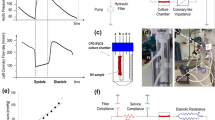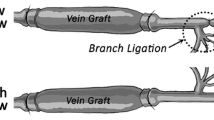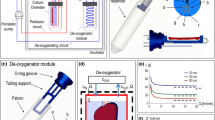Abstract
The great saphenous vein (GSV) has served as a coronary artery bypass graft (CABG) conduit for over 50 years. Despite prevalent use, first-year failure rates remain high compared to arterial autograft options. Amongst other factors, vein graft failure can be attributed to material and mechanical mismatching that lead to apoptosis, inflammation, and intimal-medial hyperplasia. Through the implementation of the continuum mechanical-based theory of “stress-mediated growth and remodeling,” we hypothesize that the mechanical properties of porcine GSV grafts can be favorably tuned for CABG applications prior to implantation using a prolonged but gradual transition from venous to arterial loading conditions in an inflammatory and thrombogenic deficient environment. To test this hypothesis, we used a hemodynamic-mimetic perfusion bioreactor to guide remodeling through stepwise incremental changes in pressure and flow over the course of 21-day cultures. Biaxial mechanical testing of vessels pre- and post-remodeling was performed, with results fit to structurally-motivated constitutive models using non-parametric bootstrapping. The theory of “small-on-large” was used to describe appropriate stiffness moduli, while histology and viability assays confirmed microstructural adaptations and vessel viability. Results suggest that stepwise transition from venous-to-arterial conditions results in a partial restoration of circumferential stretch and circumferential, but not axial, stress through vessel dilation and wall thickening in a primarily outward remodeling process. These remodeled tissues also exhibited decreased mechanical isotropy and circumferential, but not axial, stiffening. In contrast, only increases in axial stiffness were observed using culture under venous perfusion conditions and those tissues experienced moderate intimal resorption.








Similar content being viewed by others
References
Baek, S., R. L. Gleason, K. R. Rajagopal, and J. D. Humphrey. Theory of small on large: potential utility in computations of fluid–solid interactions in arteries. Comput. Methods Appl. Mech. Eng. 196:3070–3078, 2007.
Bellini, C., J. Ferruzzi, S. Roccabianca, E. S. Di Martino, and J. D. Humphrey. A microstructurally motivated model of arterial wall mechanics with mechanobiological implications. Ann. Biomed. Eng. 42:488–502, 2014.
Benedetto, U., S. G. Raja, A. Albanese, M. Amrani, G. Biondi-Zoccai, and G. Frati. Searching for the second best graft for coronary artery bypass surgery: a network meta-analysis of randomized controlled trials. Eur. J. Cardiothorac. Surg. 47:59–65, 2015.
Bersi, M. R., J. Ferruzzi, J. F. Eberth, R. L. Gleason, Jr, and J. D. Humphrey. Consistent biomechanical phenotyping of common carotid arteries from seven genetic, pharmacological, and surgical mouse models. Ann. Biomed. Eng. 42:1207–1223, 2014.
Carey, J. S., B. Danielsen, J. Milliken, Z. Li, and B. E. Stabile. Narrowing the gap: early and intermediate outcomes after percutaneous coronary intervention and coronary artery bypass graft procedures in California, 1997 to 2006. J. Thorac. Cardiovasc. Surg. 138:1100–1107, 2009.
Chen, Y. C., and J. F. Eberth. Constitutive function, residual stress, and state of uniform stress in arteries. J. Mech. Phys. Solids 60:1145–1157, 2012.
Cyron, C. J., and J. D. Humphrey. Growth and remodeling of load-bearing biological soft tissues. Meccanica 52:645–664, 2017.
de Vries, M. R., K. H. Simons, J. W. Jukema, J. Braun, and P. H. A. Quax. Vein graft failure: from pathophysiology to clinical outcomes. Nat. Rev. Cardiol. 13:451–470, 2016.
Dummler, S., S. Eichhorn, C. Tesche, U. Schreiber, B. Voss, M. A. Deutsch, H. Hauner, H. Lahm, R. Lange, and M. Krane. Pulsatile ex vivo perfusion of human saphenous vein grafts under controlled pressure conditions increases MMP-2 expression. Biomed. Eng. Online 10:62, 2011.
Eberth, J. F., N. Popovic, V. C. Gresham, E. Wilson, and J. D. Humphrey. Time course of carotid artery growth and remodeling in response to altered pulsatility. Am. J. Physiol. Hear. Circ. Physiol. 299:H1875–H1883, 2010.
Eberth, J. F., A. I. Taucer, E. Wilson, and J. D. Humphrey. Mechanics of carotid arteries in a mouse model of marfan syndrome. Ann. Biomed. Eng. 37:1093–1104, 2009.
Ferruzzi, J., M. R. Bersi, and J. D. Humphrey. Biomechanical phenotyping of central arteries in health and disease: advantages of and methods for murine models. Ann. Biomed. Eng. 41:1311–1330, 2013.
Ferruzzi, J., D. A. Vorp, and J. D. Humphrey. On constitutive descriptors of the biaxial mechanical behaviour of human abdominal aorta and aneurysms. J. R. Soc. Interface 8:435–450, 2011.
Fung, Y. C. What are the residual stresses doing in our blood vessels? Ann. Biomed. Eng. 19:237–249, 1991.
Fung, Y. C., and S. Q. Liu. Strain distribution in small blood vessels with zero-stress state taken into consideration. Am. J. Physiol. 262:H544–H552, 1992.
Goldman, S., K. Zadina, T. Moritz, T. Ovitt, G. Sethi, J. G. Copeland, L. Thottapurathu, B. Krasnicka, N. Ellis, R. J. Anderson, and W. Henderson. Long-term patency of saphenous vein and left internal mammary artery grafts after coronary artery bypass surgery: results from a Department of Veterans Affairs Cooperative Study. J. Am. Coll. Cardiol. 44:2149–2156, 2004.
Gomez, D., and G. K. Owens. Smooth muscle cell phenotypic switching in atherosclerosis. Cardiovasc. Res. 95:156–164, 2012.
Gooch, K. J., M. S. Firstenberg, B. S. Shrefler, and B. W. Scandling. Biomechanics and mechanobiology of saphenous vein grafts. J. Biomech. Eng. 140:020804, 2018.
Gusic, R. J., R. Myung, M. Petko, J. W. Gaynor, and K. J. Gooch. Shear stress and pressure modulate saphenous vein remodeling ex vivo. J. Biomech. 38:1760–1769, 2005.
Gusic, R. J., M. Petko, R. Myung, J. William Gaynor, and K. J. Gooch. Mechanical properties of native and ex vivo remodeled porcine saphenous veins. J Biomech 38:1770–1779, 2005.
Hocking, K. M., B. Sileshi, F. J. Baudenbacher, R. B. Boyer, K. L. Kohorst, C. M. Brophy, and S. S. Eagle. Peripheral venous waveform analysis for detecting hemorrhage and iatrogenic volume overload in a porcine model. Shock 46:447–452, 2016.
Holzapfel, G. A., T. C. Gasser, and R. W. Ogden. A new constitutive framework for arterial wall mechanics and a comparative study of material models. J. Elast. Phys. Sci. solids 61:1–48, 2000.
Humphrey, J. D. Cardiovascular Solid Mechanics: Cells, Tissues, and Organs. New York: Springer, 2002.
Humphrey, J. D., J. F. Eberth, W. W. Dye, and R. L. Gleason. Fundamental role of axial stress in compensatory adaptations by arteries. J. Biomech. 42:1–8, 2009.
Kamenskiy, A., A. Seas, P. Deegan, W. Poulson, E. Anttila, S. Sim, A. Desyatova, and J. MacTaggart. Constitutive description of human femoropopliteal artery aging. Biomech. Model. Mechanobiol. 16:681–692, 2017.
Kamiya, A., and T. Togawa. Adaptive regulation of wall shear stress to flow change in the canine carotid artery. Am. J. Physiol. 239:H14–H21, 1980.
Kassab, G. S., and J. A. Navia. Biomechanical considerations in the design of graft: the homeostasis hypothesis. Annu. Rev. Biomed. Eng. 8:499–535, 2006.
Kinsky, M., N. Ribeiro, M. Cannesson, D. Deyo, G. Kramer, M. Salter, M. Khan, H. Ju, and W. E. Johnston. Peripheral venous pressure as an indicator of preload responsiveness during volume resuscitation from hemorrhage. Anesth. Analg. 123:114–122, 2016.
Langleben, D., J. L. Szarek, J. T. Coflesky, R. C. Jones, L. M. Reid, and J. N. Evans. Altered artery mechanics and structure in monocrotaline pulmonary hypertension. J. Appl. Physiol. 65:2326–2331, 1988.
Latorre, M., and J. D. Humphrey. Modeling mechano-driven and immuno-mediated aortic maladaptation in hypertension. Biomech. Model. Mechanobiol. 17:1497–1511, 2018.
Matsumoto, T., and K. Hayashi. Mechanical and dimensional adaptation of rat aorta to hypertension. J. Biomech. Eng. 116:278–283, 1994.
McAnulty, R. J., and G. J. Laurent. Collagen synthesis and degradation in vivo. Evidence for rapid rates of collagen turnover with extensive degradation of newly synthesized collagen in tissues of the adult rat. Coll. Relat. Res. 7:93–104, 1987.
Parang, P., and R. Arora. Coronary vein graft disease: pathogenesis and prevention. Can. J. Cardiol. 25:e57–e62, 2009.
Prim, D. A., V. Menon, S. Hasanian, L. Carter, T. Shazly, J. D. Potts, and J. F. Eberth. Perfusion tissue culture initiates differential remodeling of internal thoracic arteries, radial arteries, and saphenous veins. J. Vasc. Res. 55:255–267, 2018.
Prim, D. A., M. A. Mohamed, B. A. Lane, K. Poblete, M. A. Wierzbicki, S. M. Lessner, T. Shazly, and J. F. Eberth. Comparative mechanics of diverse mammalian carotid arteries. PLoS ONE 13:e0202123, 2018.
Prim, D. A., J. Potts, and J. F. Eberth. Pulsatile perfusion bioreactor for biomimetic vascular impedances. J. Med. Device. 12:041002, 2018.
Prim, D. A., B. Zhou, A. Hartstone-Rose, M. J. Uline, T. Shazly, and J. F. Eberth. A mechanical argument for the differential performance of coronary artery grafts. J. Mech. Behav. Biomed. Mater. 54:93–105, 2016.
Ramachandra, A. B., J. D. Humphrey, and A. L. Marsden. Gradual loading ameliorates maladaptation in computational simulations of vein graft growth and remodelling. J. R. Soc. Interface 14:20160995, 2017.
Rensen, S. S. M., P. A. F. M. Doevendans, and G. J. J. M. van Eys. Regulation and characteristics of vascular smooth muscle cell phenotypic diversity. Neth. Heart J. 15:100–108, 2007.
Ross, M., and W. Pawlina. Histology: A Text and Atlas. Philadelphia: Wolters Kluwer, pp. 184–191, 2004.
Sodek, J., and J. M. Ferrier. Collagen remodelling in rat periodontal tissues: compensation for precursor reutilization confirms rapid turnover of collagen. Coll. Relat. Res. 8:11–21, 1988.
Van Loon, P. Length-force and volume-pressure relationships of arteries. Biorheology 14:181–201, 1976.
Yin, F. C. P., P. H. Chew, and S. L. Zeger. An approach to quantification of biaxial tissue stress–strain data. J. Biomech. 19:27–37, 1986.
Zhou, B., D. A. Prim, E. J. Romito, L. P. McNamara, F. G. Spinale, T. Shazly, and J. F. Eberth. Contractile smooth muscle and active stress generation in porcine common carotids. J. Biomech. Eng. 140:014501, 2018.
Zhou, B., L. Wolf, A. Rachev, and T. Shazly. A structure-motivated model of the passive mechanical response of the primary porcine renal artery. J. Mech. Med. Biol. 14:1450033, 2014.
Acknowledgments
The authors would like to acknowledge the contributions of Boran Zhou (PhD), Shahd Hasanain (BS), Colton Kostelnik (BS), Laurel Carter (MD) and Nicole Carey (MD) for their technological contributions to the project.
Funding
This work is supported by the National Institutes of Health under Grant Numbers (R21 EB022131, R01HL133662, and P20GM103444).
Conflicts of interest
No benefits in any form have been or will be received from a commercial party related directly or indirectly to the subject of this manuscript.
Author information
Authors and Affiliations
Corresponding author
Additional information
Associate Editor Peter E. McHugh oversaw the review of this article.
Publisher's Note
Springer Nature remains neutral with regard to jurisdictional claims in published maps and institutional affiliations.
Electronic supplementary material
Below is the link to the electronic supplementary material.
Rights and permissions
About this article
Cite this article
Prim, D.A., Lane, B.A., Ferruzzi, J. et al. Evaluation of the Stress–Growth Hypothesis in Saphenous Vein Perfusion Culture. Ann Biomed Eng 49, 487–501 (2021). https://doi.org/10.1007/s10439-020-02582-1
Received:
Accepted:
Published:
Issue Date:
DOI: https://doi.org/10.1007/s10439-020-02582-1




